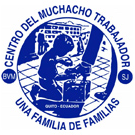 | |
| Abbreviation | CMT |
|---|---|
| Established | 1964; 61 years ago (1964) |
| Location | |
| Founder | John Halligan |
| President | John James Halligan |
| Director | Gilberto Freire |
| Affiliations | Jesuit, Catholic |
| Website | CMT |
The Working Boys' Center (Centro del Muchacho Trabajador: CMT), also known as the Center for Working Families, is a facility in Quito, founded by the Society of Jesus in 1964. It offers social programs for the human and economic development of working boys (and girls since 1974) and their families. Its stated aim is to give working children help to escape from extreme poverty and to gain control of their own lives. CMT states its approach to achieving this is by providing education for the working children and for their families, together with meals, health services, housing assistance, loans to start up microbusinesses, and cultural enhancement.
History
In 1964, the Working Boys' Center began with 200 shoeshine and street worker boys in the attic of the Church of the Society of Jesus in the old center of Quito. Early primary education was given, along with three daily meals and health care. Boys were trained in carpentry and shoemaking.
In 1974, a headquarters was set up at La Marin, a neighborhood in north Quito. Working children's families were included in a comprehensive training program, adding adult education and vocational education training in various technical skills.
In 1981, the opening of a second Working Boys' Center in northwest Quito, at Cotocollao, resulted in the extension of services to 400 families.
In 1984, the Craft Defense Board and the Ministry of Education gave official recognition to the technical education workshops. A clinic was later added to health services and health promoters were trained. Marketing was taught in a business school joined to the workshops. A training program for micro-entrepreneurs was launched and microfinance loans made available.
Product donation campaigns, begun as the CMT Milk Drop Society, led in 2002 to the Gota de Leche, 'Drop of Milk' program. This provides nutritional supplementation and health care monitoring to malnourished children, along with child development and health promotion skills classes for their parents.
At a 2015 speaking appearance at the center, Ecuadoran President Rafael Correa acknowledged its help in reducing child labor over the past eight years from over 16% to under 3%.
Education
Primary education for working children and a program for children with disabilities are offered. Technical education, extending to adults, involves training and internships in workshops while students study the specialties of automotive and industrial mechanics, carpentry and furniture-making, plumbing, cosmetology (beauty treatments), sewing and dressmaking, foodservice (restaurant and catering industry), and bakery. Adult training also offers a diploma of completion of primary education. Technical high school education with IRFEYAL (Instituto Radiofónico Fe y Alegría, a distance education service based in Quito) is also available for those who wish to continue their studies. The center has offered a degree in Automotive Mechanics and was declared by the Ministries of Education and Labor the "best technical school in the nation" in 1997 and 2002.
References
- ECUAVISA TV on Halligan and origins. Accessed 12 December 2016.
- McGuire, Caitlin; Working Boys' Center (June 2019), "Service at the Working Boys' Center: An introduction to Quito, Ecuador, and your experience at the Working Boys' Center" (PDF), Center for Working Families, p. 14, Information brochure for volunteers, retrieved 29 October 2021
- "OTRAƎDUCACION: Niños que trabajan y estudian (CMT, Ecuador)". OTRAƎDUCACION. Retrieved 2017-03-31.
- "CONDICIONES DE VIDA DE LOS NIÑOS DEL CENTRO DEL MUCHACHO TRABAJADOR E INFLUENCIA SOBRE SU DESARROLLO PERSONAL Y SOCIAL". prezi.com. Retrieved 2017-03-31.
- "Agasajo al Centro del Muchacho Trabajador". El Tiempo (in Spanish). 2016-02-25. Retrieved 2017-03-31.
- Robalino, Patricia (2015). "Teatro y libro infantil sobre bomberos presentadó Verónica Bonilla "Valentina quiere ser bombero"". Casa de la Cultura Ecuatoriana (in Spanish). House of Ecuadoran Culture: CCE Benjamín Carrión]. Archived from the original on 24 December 2016. Retrieved 30 March 2017.
This work, ... published by the House of Ecuadorian Culture, is dedicated to children and young people of the Working Boy Center (CMT)" ... "Valentina wants to be a firefighter, is for children and performed by children and youth of the CMT.
- "Beginnings". El Telegrafo. Retrieved 30 March 2017.
- ^ The Center for Working Families (2014). "Historical Timeline" (PDF). The Working Boys' Center. Retrieved 29 October 2021 – via Center for Working Families.
- ^ Lefevere, Patricia (27 March 2009). "Center teaches entire families in Ecuador". National Catholic Reporter. Retrieved 29 October 2021.
- "Historia". Centro Muchacho Trabajador Quito (in European Spanish). Archived from the original on 9 July 2019. Retrieved 2017-03-31.
- "Presidente Correa destaca reducción del trabajo infantil y ratifica compromiso para erradicarlo - ANDES". www.andes.info.ec. Retrieved 2017-03-31.
- Centro del muchacho trabajador n. 1, graduados 2010, 2010-07-06, cmtq100, retrieved 2017-03-31
- Servicio Ecuatoriano de Capacitación Profesional (23 September 2016). "SECAP certifica a trabajadoras del área textil en Pichincha". www.secap.gob.ec (in Spanish). Retrieved 2017-03-31.
- El Telegrafo on urban entrepreneurs. Accessed 12 December 2016.
- "Centro Del Muchacho Trabajador". cursos.universia.es (in Spanish). Retrieved 2017-03-31.
Further reading
- Corvalán Vásquez, Oscar; Lizarzaburu, Alfonso (1985). Los Programas de capacitación para trabajadores del sector informal en América Latina (Report) (in Spanish). Paris: UNESCO IIEP. pp. 95–102 – via UNESDOC Digital Library.
- Unda Lara, C. René; Llanos Erazo, Daniel; Herrera Montero, Luis (2014). Espacios de socialización de niños, niñas y adolescentes en el Centro del Muchacho Trabajador; ámbitos: familia, escuela y trabajo [Spaces of Socialization of Children and Adolescents in the Working Boys' Center: Family, school and work]. Quito, Ecuador: Salesian Polytechnic University; Ediciones Abya Yala. ISBN 9789978101872. OCLC 1001557953.
External links
0°6′32.44″S 78°29′40.87″W / 0.1090111°S 78.4946861°W / -0.1090111; -78.4946861
Categories: